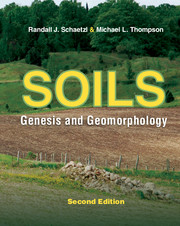4 - Basic Concepts: Soil Mineralogy
Published online by Cambridge University Press: 12 January 2024
Summary
Minerals are naturally occurring, inorganic compounds that have a characteristic chemical composition and a regular, repeating three-dimensional array of atoms in a crystal structure. Minerals can be classified according to their chemical composition and crystal structure, or according to whether they are primary (having formed directly from magma) or secondary (having formed by chemical weathering of other, preexisting minerals, either primary or secondary). Primary minerals tend to dominate in coarser size fractions of soils, whereas secondary minerals are most abundant in the clay and fine silt fractions (Fig. 2.6). Knowing the structure, properties, and origins of soil minerals is essential for understanding the processes of mineral transformation and transport, all of which are important in soil genesis. This chapter emphasizes mineral structure, classification, properties, occurrence, and identification, whereas later chapters (especially Chapters 13 and 15) focus on the role of minerals in soil genesis and geomorphology, e.g., as indicators of soil genesis, age, or paleoenvironments.
Bonding and Crystal Structures
Understanding the chemical and structural classification of minerals requires knowledge of bonding and crystal structure in inorganic solids, particularly solids in which oxygen is an anion.
Oxygen (in the form of the anion O2-) makes up about 47% (by mass) of the Earth's crust (Fig. 4.1). It is by far the most abundant element and anion in the crust. Consequently, nearly all major groups of soil minerals, including silicates, oxides, phosphates, carbonates, and sulfates, are ionic solids in which O2- is the primary anion. The most common cations in soil minerals are Si4+, Al3+, and Fe3+, reflecting their crustal abundance as well (Fig. 4.1).
The bonds between these cations and O2- are predominantly ionic, and mineral structures commonly consist of large O2- anions in close packing around a small polyvalent cation such as Si4+ or Al3+ (Fig. 4.2). The number of O2- anions that can fit around the cation in a close-packed arrangement depends on the radii of the ions involved (Fig. 4.2).
- Type
- Chapter
- Information
- SoilsGenesis and Geomorphology, pp. 50 - 70Publisher: Cambridge University PressPrint publication year: 2015



